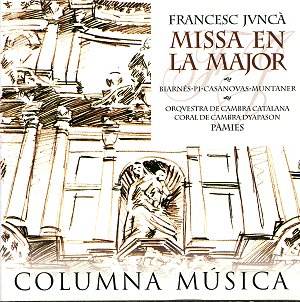The Catalan composer Francesc Juncà is a name
that is new to me. I could find nothing by him mentioned in the catalogue.
Older than Mozart, but younger than Haydn, judging by this CD his music
hovers on the edge between late-baroque and classical, without breaking
any new ground. Born in 1742, he may have been a choir boy at the Montserrat
Monastery. He went on to work as a second choir master at Santa Maria
del Mar in Barcelona. In 1774 he was appointed choir master at Girona
Cathedral. From 1780 he was choir master in Toledo and then in 1792
the King appointed him a Canon of Girona Cathedral where he died in
1833. He enjoyed great prestige in his lifetime, composing over 300,
mainly sacred, works. This mass in A major dates from 1777 whilst Juncà
was choirmaster at Girona Cathedral. It was transcribed by the conductor,
Joan Pàmies, and received its first performance in modern times
at the Cathedral of Girona during the 1999 Spring Festival.
The mass is stylistically parallel to those of Mozart
and Haydn. Musically it is efficient enough and not without interest.
I am sure that, in context, it would have made a fine, uplifting contribution
to the literature. But the music is without that spark that turns the
merely interesting into a work of genius. It has a rather curious construction.
The Kyrie lasts 8 minutes, the Gloria 25 minutes and the Credo 14 minutes,
whereas the Sanctus lasts a mere 2 minutes and the Agnus Dei less than
3 minutes. This rather leaves the piece sounding top heavy. Also the
Agnus Dei consists of only the final one (with the words Dona nobis
pacem), so presumably the first two were sung to plainchant. The booklet
does not say. Perhaps the Sanctus also mixed plainchant and polyphony.
The mass opens with a rather perky instrumental movement
which leads into a surprisingly dramatic and sombre choral Kyrie. This
raises the hopes that the work will develop into something dramatic
and significant, but this mood is not sustained and the piece proceeds
with an attractive mixture of solos and choral interjections. Only occasionally
do things fail to rise above the level of note-spinning.
The mass is scored for violins (evidently no violas),
2 oboes, 2 horns, cellos, double bass and bassoon. Organ and bajon are
used to reinforce the choir. The choir itself is divided into two, with
the second choir simply reinforcing the first in the tutti sections.
I must confess, that I could not really detect much difference in the
choral sections so if the performers were using tutti and ripieno sections
in the choir, it is was done very discreetly.
The soloists generally cope quite decently with the
rather taxing solo lines, though Olivia Biarnés (soprano) has
a tendency to go rather shrill in her upper-most register and can have
tuning problems. Montserrat Pi (contralto) copes well with what I presume
to be a haut-contre part, but as a result she sounds uncomfortably plummy.
This is most noticeable in the long 'Laudamus te' solo where the vocal
line sounds unreasonably congealed when compared to the wonderfully
transparent accompaniment. Bass, Rafael Muntaner, has a curious veiled
quality to his voice and frankly some of his contributions, such as
the opening of the Gloria, are rather boring. Tenor, Jordi Casanovas,
has a fine open-throated technique but stylistically he does not really
seem suited to this music.
Stylistic matters are the biggest problem with the
soloists. None of them seems comfortable with the rather elaborate passage
work. They can sing it efficiently enough, but never make anything more
of it. What I feel is badly lacking is any sense of shape or line to
the music, the feeling that all these notes add up to anything more.
Too often the passage work is, at its best, adequate but boring and
at its worst rather sketchy and not a little squally.
The booklet gives no indication of the type of voices
that Juncà was writing for. Was the cathedral of Girona using
female sopranos (unlikely) or was the soprano part written for a boy
treble or a high falsettist (the Spanish court had been famous for its
high falsettists. It would be interesting to know whether this applied
to Girona Cathedral in the late 18th century.). As I have
said above, the alto part certainly sounds as if it was written with
a high tenor/haut-contre in mind and I would love to hear it sung in
this manner. The other stylistic issue related to this is of course
pitch. It sounds as if the Orquestra de Cambra Catalana play on modern
instruments so there is the added complication of how late 18th
century Calatan ecclesiastical pitch relates to modern pitch. But these
are small points. Joan Pàmies and his team are to be congratulated
for their work in unearthing this music and allowing us to hear it again.
The orchestra have a fine grasp of the style and play
crisply and elegantly. Conductor Joan Pàmies judges the tempi
nicely and has a fine grasp on the structure of the work. The recording
seems to have been made in a rather generous acoustic, but has been
fairly closely miked. This can give a slightly odd acoustic halo to
the music and means that the soloists are sometimes uncomfortably close.
Whilst not perfect, this enterprising recording fills
a significant gap in the catalogue. Whether Juncà warrants significant
exposure, I am not sure. But it is most welcome to be able to hear some
of his charming music in a performance that is more than adequate. It
would be interesting to hear his music again in performances on period
instruments.
Robert Hugill
